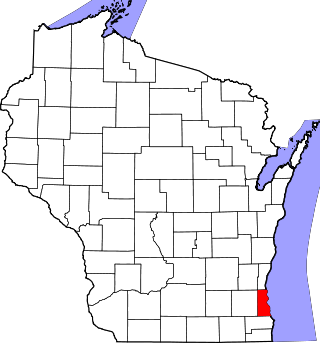
This list comprises buildings, sites, structures, districts, and objects in Milwaukee County, which are listed on the National Register of Historic Places. There are 289 NRHP sites listed in Milwaukee County, including 216 in the City of Milwaukee included in the National Register of Historic Places listings in Milwaukee, Wisconsin and 73 outside of the city, listed below. Eight previously listed sites have been removed.
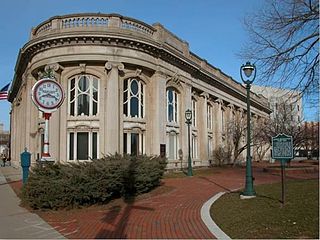
The Milwaukee County Historical Society, also known as MCHS, is a local historical society in Milwaukee County, Wisconsin. Founded in 1935, the organization was formed to preserve, collect, recognize, and make available materials related to Milwaukee County history. It is located in downtown Milwaukee in the former Second Ward Savings Bank building.

The Merchants Avenue Historic District in a residential neighborhood southeast of the downtown in Fort Atkinson, Wisconsin, composed of 33 mostly large homes on large lots within six city blocks around Merchants Avenue. It was placed on the United States National Register of Historic Places in 1986.

The Rufus Arndt House in Whitefish Bay, Wisconsin, United States, was built in 1925. It was designed by Ernest Flagg in a style that suggests Tudor Revival and Cotswold Cottage and built by the Arnold F. Meyer & Co. One of the Ernest Flagg Stone Masonry Houses of Milwaukee County, this residence was listed on the National Register of Historic Places on September 12, 1985.

The Church Hill Historic District is a mid-to-upper-class residential area north of Portage's downtown. It was added to the National Register of Historic Places in 1997 for its significance in architecture and social history.

The Mansion Hill Historic District encompasses a part of the Mansion Hill neighborhood northwest of the capitol square in Madison, Wisconsin. In the 19th century the district was home to much of Madison's upper class, and held the largest concentration of large, ornate residences in the city, but in the 20th century it shifted to student housing. In 1997 the district was added to the National Register of Historic Places.

The Church Street Historic District is a one-block neighborhood of historic homes built from about 1857 to 1920. It was added to the National Register of Historic Places in 1989.

The Lowell Damon House is a historic house located at 2107 Wauwatosa Avenue in Wauwatosa, Wisconsin built from 1844 to 1846, displaying a design unusual for Wisconsin. It was added to the National Register of Historic Places on February 23, 1972.

The Juneau Highlands Residential Historic District is a historic neighborhood in West Allis, Wisconsin, with contributing homes built from 1928 to 1952. It was added to the National Register of Historic Places in 2011.

The Wauwatosa Woman's Club Clubhouse is located in Wauwatosa, Wisconsin. It was added to the National Register of Historic Places in 1998.
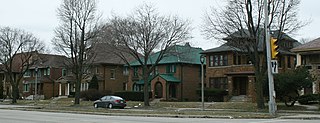
The North Sherman Boulevard Historic District is a largely intact neighborhood of stylish homes built from 1907 to 1955 in Milwaukee, Wisconsin. It was added to the National Register of Historic Places in 2004.
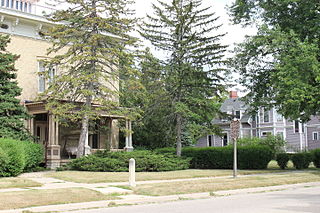
The Courthouse Hill Historic District is a 30-block area on the east side of Janesville, Wisconsin, containing many historic structures built from the mid-1800s to the early 1900s in various styles, including homes of many of Janesville's influential leaders from that period. The district was added to the National Register of Historic Places in 1986.

The Maple Park Historic District is a historic neighborhood that lies northwest of the downtown of Lake Geneva, Wisconsin, United States. Part of the original city plat for Lake Geneva, it was first home to early settlers before the town became known as a retreat for wealthy Chicagoans. The district was added to the National Register of Historic Places in 2005.
The West Washington-North Hi-Mount Boulevards Historic District is a historic neighborhood in Milwaukee, Wisconsin, with stylish homes built along the named streets beginning in 1912, mostly businessmen and professionals. In 1994 the district was listed on the National Register of Historic Places.

The Milwaukee County School of Agriculture and Domestic Economy Historic District is the building complex of an agriculture school started in 1912 in Wauwatosa, Wisconsin, when farming was a big part of Milwaukee County's economy. In 1998 the complex was listed on the National Register of Historic Places.

The Jenifer-Spaight Historic District is a historic neighborhood a mile east of the capitol in Madison, Wisconsin, including houses built as early as 1854. In 2004 the district was added to the National Register of Historic Places (NRHP).

The Langdon Street Historic District is a historic neighborhood east of the UW campus in Madison, Wisconsin - home to some of Madison's most prominent residents like John B. Winslow, Chief Justice of the state Supreme Court, and nationally recognized historian Frederick Jackson Turner. The district has a high concentration of period revival style buildings - many built from 1900 to 1930 to house Greek letter societies, and many designed by Madison's prominent architects. In 1986 the district was added to the National Register of Historic Places.

The Orton Park Historic District is a residential historic district on the near east side of Madison, Wisconsin. The district is centered on Orton Park, the first public park in Madison, and includes 56 houses facing or near to the park. The first houses in the area were built in the 1850s during a local housing boom; however, after the Panic of 1857 ended the boom, development in the area halted. When Orton Park was developed out of a former cemetery in the 1880s, more houses were built near the park; construction in the district continued through the 1950s. Many houses in the district were designed in the Queen Anne, Prairie School, and Craftsman styles, and local architects Claude and Starck designed at least seven houses in the district. The district also includes examples of Greek Revival, Italianate, and Colonial Revival architecture.

The Shorewood Historic District is a large neighborhood on the west side of Shorewood Hills, Wisconsin - homes built in various styles between 1924 and 1963. In 2002 the district was listed on the National Register of Historic Places.
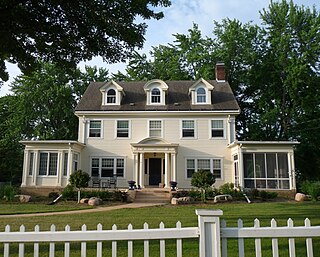
The West Fifth Street-West Sixth Street Historic District is part of an older neighborhood west of the downtown in Marshfield, Wisconsin. It consists of 58 homes built from 1900 to 1958 in many of the styles from that period, including homes of some of Marshfield's leaders. In 2006 the district was placed on the National Register of Historic Places for its concentration of intact historical architecture.




















